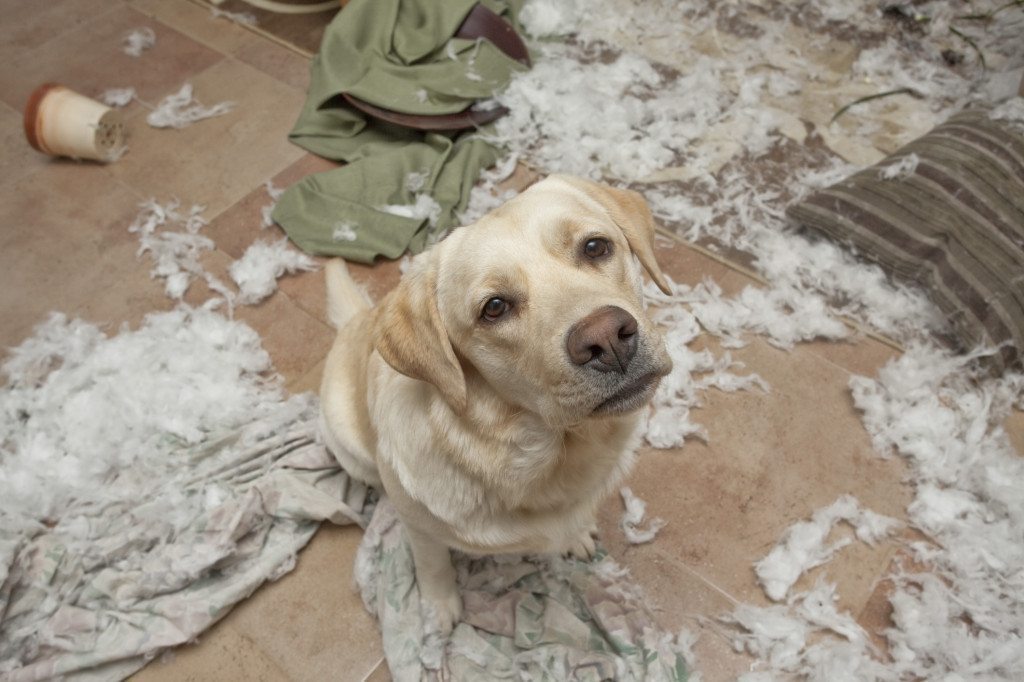 Many years ago, a friend of mine adopted a yellow labrador from her local humane society. Since it was Taz’s third home in just his first year of life, it wasn’t surprising he suffered from separation anxiety. Just how bad it was didn’t become apparent until one day she left for work and Taz went through a glass pane in her door to avoid being left alone.
Many years ago, a friend of mine adopted a yellow labrador from her local humane society. Since it was Taz’s third home in just his first year of life, it wasn’t surprising he suffered from separation anxiety. Just how bad it was didn’t become apparent until one day she left for work and Taz went through a glass pane in her door to avoid being left alone.
Separation anxiety in dogs is defined by pets.webmd.com as “dogs (that) are disruptive or destructive when left alone” due to the dog having high anxiety and distress. Dogs may drool, urinate and defecate (even housetrained dogs), bark, howl, whine, pace, scratch, chew, dig, try to escape (like Taz) or exhibit other separation anxiety behaviors. All these symptoms are triggered by one thing, being left alone. (True separation anxiety behavior in dogs don’t happen in the presence of the owner.)
What Causes Separation Anxiety in Dogs?
According to the ASPCA, “there is no conclusive evidence showing exactly why dogs develop separation anxiety. However … it is believed that loss of an important person or group of people … can lead to separation anxiety in dogs.” This is most likely what happened to Taz.
Also, dogs are creatures of habit and changes (big or small) in their routine could lead to separation anxiety, including:
- Changes in Schedule: A sudden change in when – or how long – a dog is left alone; and
- Changes in Residence: Moving to a new and unfamiliar home.
Addressing Separation Anxiety in Dogs
This type of anxious behavior will not go away by itself. It will actually get worse if left unchecked leaving the dog increasingly more stressed and susceptible to greater self-injury as time goes on. It’s recommended that you consult with a trainer and behaviorist for an accurate diagnosis before starting behavior modification program.
To address Taz’s separation anxiety, my friend introduced a new routine. She would ask Taz to sit (calmly) and reward that behavior with a treat each time before she left. It started with short absences (around the corner out of sight) and slowly each absence grew longer. Within a short amount of time, Taz was secure with his new, positive routine – and yummy stuffed Kong toy – and never tried to escape again.
My friend’s solution is an example of counter-conditioning. “Counter-conditioning involves changing your dog’s association with a scary or arousing stimulus from negative to positive.” explains Whole Dog Journal. In Taz’s case, the fear of being alone was replaced by a job (sitting) and then tasty rewards (the treat and the Kong toy). Over time, he learned to develop a new – and positive – association between being left alone and his favorite treats. (The Whole Dog Journal calls these “safety cues” – word(s) or action(s) that tell the dog you’ll be back.)
The Kong also acted as a calming mechanism for Taz and directed his attention to something interesting, delicious and most importantly, positive and away from his fear of being left alone. The Kong toy was only used when Taz was left alone thereby heightening its value and positive association even more.
For the rest of his life, Taz always received a treat when his owner left the house. There was tremendous security in that simple routine that helped Taz calmly deal with being alone.
Dogs need time to associate a new positive feeling with an old problem. Never get frustrated or angry with your dog, this will only compound the problem by adding additional fear and anxiety to an existing, stressful reaction. Stay consistent and patient and give your dog time to re-adjust. Also encourage your dog to be independent, even when you’re home so when they are alone, they can be happy and secure knowing you’ll be back.
Helpful Tips For Calming Separation Anxiety in Dogs
- Exercise your dog before you depart. Exercise helps relieve built up tension and helps the dog relax.
- Some dogs have responded well to Comfort Zone plug ins. The pheromones provide a calming effect.
- Mix up your departure routine and do things out of your normal order. This will help defuse the tension from building up.
Photo: Thinkstock









